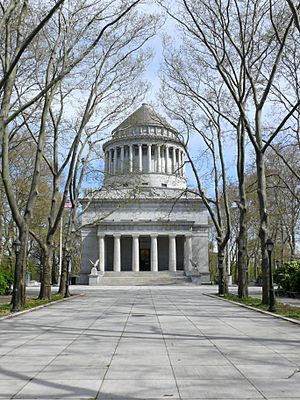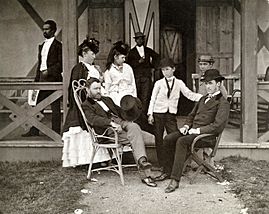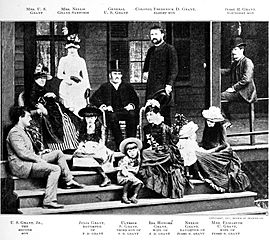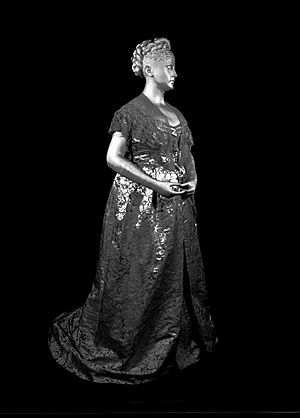Julia Grant facts for kids
Quick facts for kids
Julia Grant
|
|
|---|---|
 |
|
| First Lady of the United States | |
| In role March 4, 1869 – March 4, 1877 |
|
| President | Ulysses S. Grant |
| Preceded by | Eliza Johnson |
| Succeeded by | Lucy Hayes |
| Personal details | |
| Born |
Julia Boggs Dent
January 26, 1826 St. Louis, Missouri, U.S. |
| Died | December 14, 1902 (aged 76) Washington, D.C., U.S. |
| Resting place | General Grant National Memorial Manhattan, New York |
| Spouse | |
| Children |
|
| Signature | |
Julia Boggs Grant (born Julia Dent; January 26, 1826 – December 14, 1902) was the First Lady and wife of President Ulysses S. Grant. The First Lady is the title given to the wife of the U.S. President. Julia became a well-known person in her own right during her time as First Lady. Her life story, called The Personal Memoirs of Julia Dent Grant, was published in 1975.
Contents
- Julia Grant's Early Life
- Julia's Eyesight and Strabismus
- Julia's Engagement and Marriage to Ulysses Grant
- Early Married Life and Family
- Julia's Role During the Civil War
- The Grant Children
- Julia Grant as First Lady
- Julia's Views on Women's Rights
- Julia's Views on Slavery and Race
- Julia Grant's Later Life
- Images for kids
- See also
Julia Grant's Early Life
Julia Boggs Dent was born on January 26, 1826. Her birthplace was the White Haven plantation near St. Louis, Missouri. Her parents were Frederick Dent and Ellen Wrenshall Dent. Julia was the fifth of eight children in her family.
In her memoirs, Julia described her childhood as very happy. She said it was "one long summer of sunshine, flowers, and smiles."
Julia's Education and Schooling
From about 1831 to 1836, Julia went to the Gravois School in St. Louis. This was a one-room school for both boys and girls.
When she was 10, Julia started attending the Misses Mauros' boarding school in St. Louis. She stayed there during the week and went home on weekends. She studied there until she was 17.
Family Friends and Hobbies
The Dent family enjoyed having many visitors. Important people from cities like Cincinnati and Louisville often came to their home. William Clark (from the famous Lewis and Clark Expedition) and politician Alexander McNair were friends of the family.
As a young woman, Julia was very talented. She played the piano well and was an expert at riding horses. She also loved to read many novels.
Julia's Eyesight and Strabismus
Julia was born with a condition called strabismus. This is more commonly known as "crossed eyes." It means her eyes did not always look in the same direction.
When she was younger, a top surgeon offered to fix her eyes with a simple operation. However, Julia did not want to have surgery and said no.
Ulysses Grant's Love for Her Eyes
After her husband became president, Julia thought about the surgery again. She felt it was important to look her best since her husband was so famous.
But Ulysses did not want her to change her eyes. He told her, "Did I not see you and fall in love with you with these same eyes? I like them just as they are." He also said she should not try any experiments, as he might not like her as much with different eyes.
Because her strabismus was never corrected, Julia usually posed sideways in pictures. This way, her eyes would look more even.
Julia's Engagement and Marriage to Ulysses Grant
While he was a student at West Point, Julia's brother Fred Dent told her about a fellow student, Ulysses S. Grant. Fred said Ulysses was "pure gold" and wanted Julia to meet him.
In 1844, Ulysses Grant started visiting the Dent family. He and Julia became close. One day, Julia's pet canary died. Ulysses made a tiny yellow coffin and held a funeral for the bird with eight other officers.
A Special Dream and Engagement
In April 1844, Ulysses asked Julia to wear his class ring. This was a sign of their special affection. Julia was 18 at the time.
Soon after, Grant's army group was sent to Louisiana for the Mexican War. Julia was very sad about their separation. She had a strong dream that Ulysses would return in a few days, wearing regular clothes, and stay for a week. Even though it seemed unlikely, Ulysses did return just as Julia had dreamed. They then became engaged.
In July 1848, after being apart for four years, Grant's group came back to the U.S. He took time off to plan his wedding in St. Louis. Grant's father, Jesse Grant, did not attend the wedding on August 22, 1848. He did not object to Julia herself, but to her family owning slaves.
Early Married Life and Family
After they married, Ulysses went back to the Army. Julia gave birth to their first son, Frederick Dent Grant, in 1850. Their second son, Ulysses Simpson Grant Jr., was born in 1852. During this time, her husband was stationed far away on the West Coast.
Ulysses did not like being so far from his family. In 1854, he left the Army. The Grants then moved to a small farm near St. Louis called "Hardscrabble."
Financial Struggles and New Beginnings
At one point, Ulysses bought a slave from Julia's brother. However, even when he was in debt and struggling, Grant freed the slave in 1859 instead of selling him.
Ulysses later became sick with malaria and could not manage his farm. The family moved in with Julia's parents at White Haven. After he recovered, he worked collecting rents for a real estate company. But he still could not earn enough money.
By 1860, Grant needed help. He asked his father for a job in the family's leather business. He worked under his two younger brothers and earned $600 a year. This helped him get his family out of debt. So, he moved Julia and their children to Illinois.
Julia's Role During the Civil War
When the Civil War began, Ulysses helped organize volunteer soldiers. He quickly became a general. Ulysses missed his wife, so he sent for Julia. She left their children with relatives.
During the war, Julia stayed with Ulysses during his military campaigns. She traveled to places like Memphis, Vicksburg, Nashville, and Virginia. Julia traveled over 10,000 miles in four years to be with her husband. Her presence cheered him up and made him feel more confident.
In 1864, President Lincoln made Grant the commander of all Union armies. Lincoln knew how much Julia helped Ulysses, so he sent for her to join her husband.
The Grant Children
Julia and Ulysses Grant had three sons and one daughter:
- Frederick Dent Grant (1850–1912) – He became a soldier and public official.
- Ulysses Simpson Grant Jr. (1852–1929) – Known as "Buck," he became a lawyer.
- Ellen Wrenshall Grant (1855–1922) – Known as "Nellie," she was a homemaker.
- Jesse Root Grant (1858–1934) – He became an engineer.
Julia Grant as First Lady
Julia was very excited when her husband was chosen to run for president in 1868. She was even more excited than he was! She worked hard on his campaign. After he became president, Ulysses S. Grant turned to his wife and said, "And now, my dear, I hope you're satisfied."
After four years of war, a president's assassination, and a president's trial, Washington D.C. was ready for some fun. Julia made sure to provide it. She hosted many events and became a popular hostess. She planned grand state dinners with expensive foods and drinks. She also welcomed visitors at informal parties. The only rules were that ladies wore hats and men left their weapons at home.
Julia also wanted the role of First Lady to be seen as important. She believed it should have the same respect as the wives of leaders from other countries. She was upset when the role was not publicly recognized. She worked to improve the standing of wives of diplomats, cabinet members, and Supreme Court justices.
White House Wedding and Farewell
As First Lady, Julia held public receptions every Tuesday afternoon. As mentioned, her only rules were that ladies wore hats and men left their weapons at home.
On May 21, 1874, the Grants' daughter Nellie married Algernon Charles Frederick Sartoris. He was a wealthy English singer. This was the first grand wedding held in the White House. The East Room was completely redecorated for the special event.
Julia was very sad in 1875 when her husband decided not to run for a third term as president.
When the 1876 presidential election was disputed, Julia saw a chance to stay in the White House longer. She thought her husband should remain president until the issue was solved. She said her plan would have been to "hold the fort until another election could be held." Her husband disagreed. When Congress decided the election in favor of Rutherford B. Hayes, Julia got ready to leave the White House.
Julia Grant was the first First Lady to be recorded on film.
Julia's Views on Women's Rights
Julia was a strong supporter of women's rights. She did not allow jokes that made fun of women to be told when she was around. Anyone who questioned what women could do or if they were equal to men would make her angry.
While she believed in women's abilities, she was not sure if women should work outside the home. She also did not publicly support women's right to vote. However, she refused to sign a petition against women's suffrage, which many people noticed.
Julia's Views on Slavery and Race
Julia grew up on a plantation where slaves worked. As a young woman, she had a slave known as "Jule" or "Black Julia." It is not fully clear if Jule legally belonged to Julia. Historians still discuss whether Julia's father kept legal ownership of the four slaves his daughter said she owned. Julia's father wanted them to leave the slaves with him when the Grants lived in the North. He was afraid the slaves would escape to freedom.
Jule traveled with Julia Grant throughout the Civil War. In January 1862, Abraham Lincoln received a letter complaining about Grant's drinking and his wife having a slave. But Lincoln did not take any action. In her memoirs, Julia remembered, "When I visited the General during the war, I nearly always had Jule with me as a nurse."
According to Julia, "Eliza, Dan, Jule, and John belonged to me up to the time of President Lincoln's Emancipation Proclamation." This proclamation did not free slaves in Missouri. Even after that date, Jule continued to serve Julia. In January 1864, Jule, Julia, and Julia's young son Jesse left Nashville for St. Louis. On the trip, Jule left the group. Julia later remembered, "I suppose she feared to lose her freedom if she returned to Missouri." According to Julia, Jule married soon after.
Julia seemed to believe that Black people were not fully equal to white people. However, she refused to support white supremacists, including her own brother. She strongly encouraged Black staff members at the White House to buy land in Washington D.C. while it was still cheap. She wanted them to have financial security for their future. She also decided to greet anyone who was properly dressed at her afternoon receptions, no matter their race.
Julia Grant's Later Life

After Ulysses Grant's presidency, Julia and Ulysses went on a two-year world tour. They visited Europe, Africa, and Asia. After their travels, they settled in New York City to enjoy their retirement.
However, they lost all their money in a bad investment. The Grants became poor. Soon after, Ulysses was diagnosed with throat cancer, which led to his death in 1885. In his final days, Grant finished writing his Personal Memoirs. This book made enough money to make Julia and their children financially secure.
As a widow, Julia lived in Washington, D.C. There, she wrote her own memoirs. Julia Grant was the first First Lady to write a memoir. However, she could not find a publisher for it. Her book, The Personal Memoirs of Julia Dent Grant (Mrs. Ulysses S. Grant), was finally published in 1975, almost 75 years after her death.
In 1897, she attended the dedication of Grant's Tomb, a large memorial overlooking the Hudson River in New York City. She was buried next to her husband in a sarcophagus there. Julia ended her own story of their years together with a strong statement: "the light of his glorious fame still reaches out to me, falls upon me, and warms me."
While in Washington, D.C., Julia became a respected older figure, much like Dolley Madison had been. She became friends with later First Ladies, including Frances Cleveland, Caroline Harrison, and Edith Roosevelt.
Julia Grant died on December 14, 1902. She is buried with her husband in the General Grant National Memorial (Grant's Tomb) in New York City.
Images for kids
See also
 In Spanish: Julia Grant para niños
In Spanish: Julia Grant para niños






